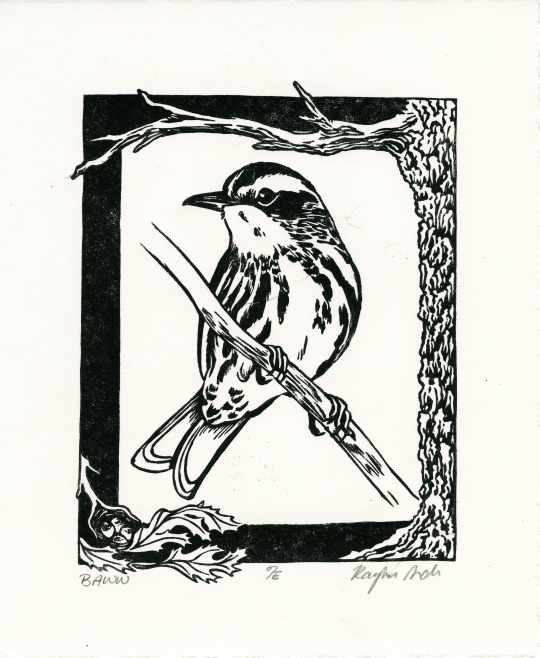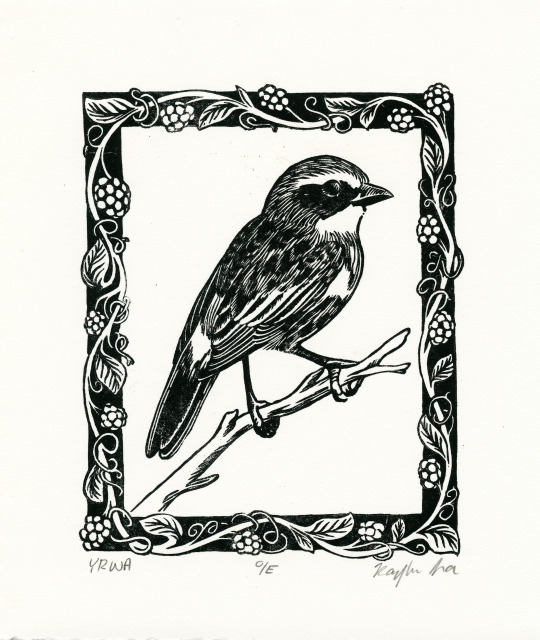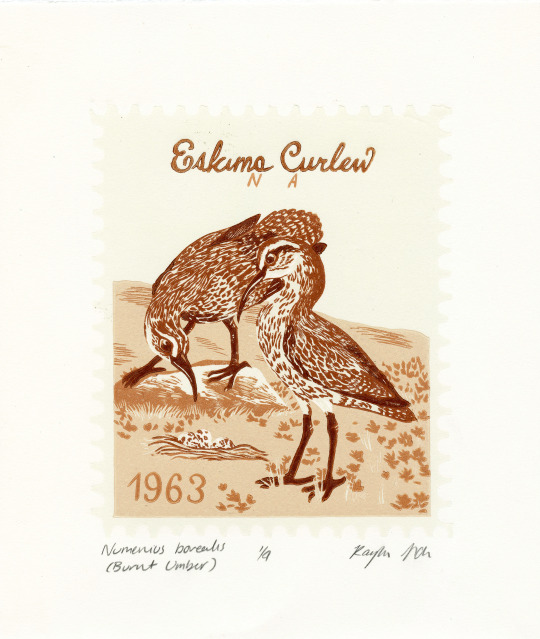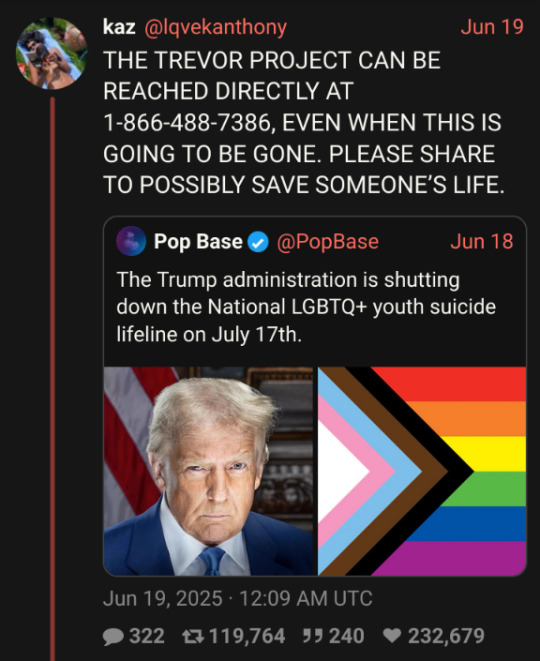24 YO printmaker and birderBig fan of little creatures https://patreon.com/RayleeSchobel
Don't wanna be here? Send us removal request.
Text

Pinguinus impennis
7-layer reduction relief print for Patreon members; June 2025
The Great Auk, Pinguinus impennis, was a large species of flightless alcid that resided in the Northern Atlantic region. The species was also known as the garefowl or penguin, and was the only modern member of the genus Pinguinus. However, they were unrelated to the penguins of the southern hemisphere, who were in fact named for their resemblance to the Great Auk.
Great Auks could be up to 33 inches tall and weighed about 11 pounds, making them the largest alcid to survive into the modern era. However, their wings were only 6 inches long, rendering them flightless. They were agile in water, but clumsy on land, making them well built for hunting fish and crustaceans but susceptible to land predators. They nested in crowded colonies on remote, rocky islands, where they mated for life and laid one egg per breeding attempt.
Great Auks were an important part of Native American culture, both as a food and clothing source and as a symbolic item. Early European explorers to America used them as a source of food and fishing bait, rapidly reducing numbers. The European population of Great Auks was largely eliminated by the mid-16th century due to high demand of their down to use in pillows.
Around the same time, some European nations began to acknowledge the decline of the species and placed regulations on hunting. However, this did little to actually stop the harvest of the species. The increase in rarity increased the demand for specimen from museums and collectors, which ultimately led to the species' demise. The last two Great Auks were killed in 1844 on Eldey, an island off the coast of Iceland, on request from a merchant who wanted specimens of the species.
#Great auk#extinct#extinct species#bird#bird art#printmaking#relief print#reduction relief#reduction linocut#auk#alcid#bird artist
232 notes
·
View notes
Text
Sign up for my email newsletter!
I send out an email ~maybe~ once a month if I'm unusually productive. I'll be sending an email tomorrow though that includes a discount for my online shop (which will also be reopening tomorrow)!
Tap the link above and fill in your email to sign up :D

1 note
·
View note
Text
There should be a troubleshooting option to figure out what’s wrong with my body.
Do I hurt because I’m hungry? Because I took my meds at the wrong time yesterday? Been too long since I’ve gone for a walk? Having a flare up? Low iron? Another vitamin B12 overdose?
I just want to hit a button to track down the root of the problem because I do NOT know how to figure it out
3 notes
·
View notes
Text
This is Stumps. He likes to watch me work
4 notes
·
View notes
Text

If I repeat it enough I’ll believe it right?
PS crayons are super difficult to work with
15 notes
·
View notes
Text

Hemignathus affinis
6-layer reduction relief print for Patreon members; May 2025
The Maui Nukupuʻu, Hemignathus affinis, was a species of nukupuʻu Hawaiian honeycreeper endemic to the island of Maui. They lived specifically in high elevations in Eastern Maui within the Hanawi Area Reserve, where insect-attracting trees like ʻōhiʻa lehua and koa provided food.
The Maui Nukupuʻu was noted as common in the 1900s, but their populations dropped so drastically that in 1963 they were thought to be extinct. However, a small population of about 28 birds was found that reignited hope for the species. Sadly, they too dwindled away and the last individual Maui nukupuʻu was seen in 1994. The species was officially declared extinct in 2023.
Before the arrival of humans to Hawaii, there were an estimated 142 unique species of birds on the islands. In 2024, 95 of those species had gone extinct, and roughly 70 percent of those that remain are considered endangered. One-third of the endangered bird species in the United States are endemic to Hawaii.
Birds that reside on islands worldwide are more at risk of extinction that birds on mainland. Not only is this because of their populations being smaller simply due to available territory, but because human interaction continuously brings hardships to native island species. Birds in the Hawaiian Islands are being hit notably hard by Avian Malaria brought by introduced mosquitoes, not to mention habitat loss and introduced predators such as cats and snakes.
#bird art#animal art#bird artist#printmaking#art#birding#relief print#reduction relief#maui#reduction linocut#reduction print#patreon#patreon artist#patreon reward
56 notes
·
View notes
Text

New (BIG) print in the works! Here’s the final drawing, done directly onto the linoleum, before carving it out to print.
I love the transiency of this stage of my printmaking process. I’ve done my research and sketch, and I’ve gone through with my pens and ink to map out a black and white drawing. If I were working on paper, making one-off ink illustrations, this would be considered a finished piece. But instead, the process is barely started. I’ll be carving out the negative space of this drawing, and of course it’s not going to match perfectly to what I have down. It’s a bit special that this full drawing was done just as an aid to the final piece, and beyond the posts about it, it won’t exist anywhere else once I start carving. Something about beauty in destruction?
I’m posting more in depth about this piece over on my Instagram, where it has a story highlight I’m trying to put my full process into
#bird art#animal art#bird artist#printmaking#art#birding#relief print#birdlr#kingfisher#belted kingfisher#art process#linocut print#linocut#linoprint#linocarving#lino art
33 notes
·
View notes
Text
This is a reminder for those who handmake Christmas presents that now is not too early to start. It may in fact be a good time to start if you have a lot to make/your craft takes a long time. You should maybe start it now, whether that's brainstorming or actually doing the crafts!
92K notes
·
View notes
Text
The men who are doing "walking challenges" around the world make me so mad. Oh you're casually walking through Iran and Afghanistan and Azerbajdzjan and whatever. Oh the people are so nice? Oh you're happily sharing a room with 3 other male strangers? Oh you got picked up by a nice group of friends who drove you for a couple hours to your next stop with no incident? Fuck you
3K notes
·
View notes
Text
Sorry I’m not looking at you when we’re talking. There’s a bird somewhere behind you I need to see
2K notes
·
View notes
Text




Warbler Full Suite
Linocut prints
#bird art#animal art#bird artist#printmaking#art#birding#relief print#birdlr#warblers#american redstart#black and white warbler#yellow rumped warbler#northern parula
739 notes
·
View notes
Text

Morning Cawfee
Linocut print on chiri paper
50 notes
·
View notes
Text

And I'm all out of Stones
Linocut print of a Ruddy Turnstone
222 notes
·
View notes
Text


For my April reduction print, I impulsively decided to try two different colorways, one with full color and one with shades of brown/burnt umber. My Patreon members were sent the full color version, but I also love the monochromatic look?
I'm working on my June print right now, and I'm using the same idea with a gray blue for the species Great Auks :) I'm really hoping it's reminiscent of an old and aged photograph.
#bird art#animal art#bird artist#printmaking#birding#art#relief print#birdlr#reduction#reduction relief#reduction linocut#curlew#eskimo curlew
5 notes
·
View notes
Text

Numenius borealis
Reduction relief print for Patreon members April 2025
"At one point, the Eskimo Curlew, Numenius borealis, was the most numerous shorebird in the tundra of western Canada and Alaska, and possibly the most numerous shorebird in North America. Historic reports of their migration from South America to their nesting grounds in the tundra talk of skies filled with the birds, and one report described a single flock covering an area of 40-50 acres of land in Nevada.
The Eskimo Curlew was a fairly large bird, and thus was seen as an ample food source for hunters. Between 1870 and 1890, the species was hunted relentlessly, much like the Passenger Pigeon years earlier. They made easy targets not only due to their size, but due to the tendency to travel in large flocks and their lack of fear of humans.
Despite the 1916 migratory bird act protecting the species from hunting, the population of Eskimo Curlews never recovered. Four photos of the bird exist, all taken by Don Bleitz on Galveston Island in 1962. The last individual harvested and confirmed sighting was in 1963 in Barbados. There have been a handful of supposed sightings since, but none are substantial enough to be considered more than hypothetical. The Eskimo Curlew retains the title of critically endangered and possibly extinct."
#bird art#animal art#bird artist#printmaking#art#birding#relief print#birdlr#curlew#eskimo curlew#reduction relief#reduction linocut#reduction print
160 notes
·
View notes
Text

Psittacula wardi
Reduction relief print for Patreon members March 2025
"The Seychelles Parakeet, Psittacula wardi, is an extinct species of parakeet that was endemic to the Seychelles Islands in the Indian Ocean. The species name, wardi, is named for British ornithologist Edward Newton, who procured the specimen that were used to first describe the bird in 1867. Only one description from life was ever made of the bird, by artist Marianne North in 1883.
Little is known about the behavior of the Seychelles Parakeet, but it's assumed that they acted very similar to their closest relative, the Alexandrine Parakeet, which live in groups and daily take flights between their nesting grounds and feeding areas. The few descriptions of Seychelles Parakeets mention that they were unimpressive in attempts at mimicry, and that they were notably "stupid." Their "stupidity" is most likely a product of island tameness, a tendency for species living on islands to lose their weariness of predators due to seclusion from mainland.
When the Seychelles Islands were first described in 1609, they were covered in thick forests and inhabited only by animals. The islands were settled by the French in 1768 and subsequently deforested. Seychelles Parakeets adapted well to cleared and cultivated areas and often ate fruit and maize grown for human consumption, and perceived damage to crops brought persecution to the species. The Seychelles Parakeet was noted as abundant in 1811, but by 1867, it was much rarer. The last confirmed individual was shot in 1893 by an American explorer, and none could be found when a search was conducted in 1906 by British ornithologist Michael John Nicoll. Some people believed that the species survived in the islet of Silhouette until the 1930s, but ornithologist Allen Hume was convinced that they were likely extinct by 1906. Joseph Forshaw, an Australian ornithologist, supposes that the species disappeared sometime between when the last specimen was collected in 1893 and Nicoll's 1906 visit."
#bird art#animal art#bird artist#printmaking#art#birding#relief print#birdlr#reductionrelief#reduction relief#reduction linocut#reduction print#parakeet#seychelles
76 notes
·
View notes
